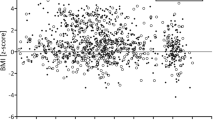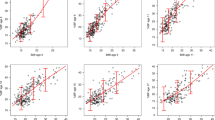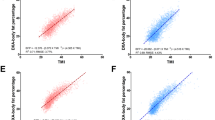Abstract
OBJECTIVE: The prevalence of obesity varies considerably between countries when compared using the common international standard. This study investigated body size and body composition in Tongan and Australian Caucasian adults.
DESIGN: Cross-sectional comparative study.
SUBJECTS: A total of 543 Tongans and 393 Australians.
MEASUREMENTS: Weight, height, waist and hip circumference, four skinfolds, midarm circumference, elbow breadth, and body composition by bioelectrical impedance using sex- and ethnic-specific regression equations.
RESULTS: Tongan women (mean body mass index (BMI)±s.e.=32.6±0.4 kg/m2) were larger than Australian women (BMI=25.8±0.4 kg/m2), with more fat-free mass (FFM; 52.2±0.4; 42.6±0.3 kg), fat mass (37.1±0.7; 26.6±0.8 kg) and percentage body fat (%fat) (40.5±0.4; 37.0±0.5%), respectively. Tongan men also had higher BMI (Tongan= 30.3±0.3 kg/m2; Australian=26.5±0.3 kg/m2), FFM (70.2±0.5; 62.3±0.6 kg) and fat mass (23.5±0.6; 20.7±0.7 kg). When compared with Australians within the same BMI range, Tongans had significantly higher FFM, elbow width, midarm muscle area and significantly lower %fat. The %fat at BMIs of 25 and 30 kg/m2 in Australian women was equivalent to the %fat found in Tongan women at 28.8 and 35.1 kg/m2, respectively. BMIs of 25 and 30 kg/m2 in Australian men corresponded with 27.5 and 35.8 kg/m2 in Tongan men. Skinfold thicknesses, waist, hip and WHR measurements suggested differences in fat distribution and body shape between ethnic groups, particularly in women.
CONCLUSION: These results suggest that the standard healthy weight ranges recommended for international use may not be appropriate standards for use in the Tongan population.
This is a preview of subscription content, access via your institution
Access options
Subscribe to this journal
Receive 12 print issues and online access
$259.00 per year
only $21.58 per issue
Buy this article
- Purchase on Springer Link
- Instant access to full article PDF
Prices may be subject to local taxes which are calculated during checkout
Similar content being viewed by others
References
World Health Organization . Obesity: preventing and managing the global epidemic Report of a WHO Consultation on Obesity World Health Organization: Geneva 1998
Singh RB, Niaz MA, Sultan A, Ghosh S . Randomised controlled trial of low energy diet in decreasing central obesity and associated disturbances Proceedings of XV International Congress of Nutrition Smith-Gordon: Adelaide 1993 690.
Wang J, Thornton JC, Russell M, Buratero S, Heymsfield S, Pierson RN . Asians have lower body mass index (BMI) but higher percent body fat than do whites: comparisons of anthropometric measurements Am J Clin Nutr 1994 60: 23–28.
Gurrici S, Hartiryanti Y, Hautvast JGAJ, Deurenberg P . Relationship between body fat and body mass index: differences between Indonesians and Dutch Caucasians Eur J Clin Nutr 1998 52: 779–783.
Thomas GN, Tomlinson B, Critchley JAJH . Guidelines for health weight. (Letter.) Br Med J 1999 341: 2097.
Swinburn BA, Craig PL, Daniel R, Prijatmoko D, Strauss B . Body composition difference between Polynesians and Caucasians assessed by bioelectrical impedance Int J Obes Relat Metab Disord 1996 20: 889–894.
Maclean E, Bach F, Badcock J . The 1986 National Nutrition Survey of the Kingdom of Tonga: Summary Report Technical Paper no. 200 South Pacific Commissions: Noumea 1992
Dignan C . South Pacific Commission Personal communication 1995
Saweri W . Look fit, be healthy Pacific Island Nutr 1997 21: 16–17.
Heymsfield SB, Lichtman S, Baumgartner RN, Wang J, Kamen Y, Aliprantis A, Pierson RN . Body composition of two improved four-compartment models that differ in expense, technical complexity, and radiation exposure Am J Clin Nutr 1990 52: 52–58.
Friedl KE, DeLuca JP, Marchitelli U, Vogel JA . Reliability of body-fat estimations from a four-compartment model by using density, body water and bone mineral assessments Am J Clin Nutr 1992 55: 764–770.
Lohman TG . Advances in body composition assessment Current Issues in Exercise Science Monograph no. 3 Human Kinetics: Champaign, IL 1992
Strauss BJG . Dual-energy Xray absorptiometry and in vivo neutron activation analysis in measuring body composition Proceedings of XV International Congress of Nutrition September 26–October 1 Smith-Gordon: Adelaide 1993
Durnin JVGA, Womersley J . Body fat assessment from total body density and its estimation from skinfold thicknesses: measurements on 481 men and women aged from 16 to 72 y Br J Nutr 1974 32: 77–97.
Heymsfield SB, McManus C, Smith J, Stevens V, Nixon DW . Anthropometric measurements of muscle mass; revisited equation for calculating bone-free muscle area Am J Clin Nutr 1982 36: 680–690.
Prentice A, Parsons TJ, Cole TJ . Uncritical use of bone mineral density in absorptiometry may lead to size-related artifacts in the identification of bone mineral determinants Am J Clin Nutr 1994 60: 837–842.
Craig P . Which body size? A cross-cultural study of body composition and body perception. Unpublished PhD thesis, Faculty of Medicine, University of Sydney, November 1999
Bland JM, Altman DG . Statistical methods for assessing agreement between two methods of clinical measurement Lancet 1986 i: 307–310.
Armitage P, Berry G . Statistical methods in medical research 2nd edn Blackwell Scientific: Oxford 1991
Statistics Department, Kingdom of Tonga . Statistical Abstract 1996 Statistics Department, Government of Tonga: Nuku'alofa, Tonga December 1998
Colagiuri S . Diabetes Prevalence Study Personal communication, October 2000
Australian Bureau of Statistics . National Nutrition Survey Australian Bureau of Statistics and Department of Health and Family Services: Canberra 1995
WHO MONICA Project . Geographical variation in the major risk factors of coronary heart disease in men and women aged 35–64 y Wld Health Stat Q 1988 41: 115–140.
Doyle F, Brown J, Lachance C . Relation between bone mass and muscle weight Lancet February 21, 1970 391–393.
Ellis KJ, Cohn SH . Correlation between skeletal calcium and muscle mass in man J Appl Physiol 1975 38: 455–460.
Himes JH, Frisancho RA . Estimating frame size. In: Lohman TG, Roche AF, Martorell R Anthropometric standardisation reference manual Human Kinetics Books; Champaign, IL 1988 121–124.
Arden NK, Spector TD . Genetic influences on muscle strength, lean body mass, and bone mineral density: a twin study J Bone Miner Res 1997 12: 2076–2081.
Piccoli A, Rossi B, Pillon L, Buciante G . A new method for monitoring body fluid variation by impedance analysis: the RXc graph Kidney Int 1994 46: 534–539.
Craig P, Ward L, Halavatau V, Fok A, Caterson I . Ethnicity and bioimpedance measurement of body composition 2nd South-West Pacific Nutrition and Dietetic Conference Auckland, New Zealand September 1999 New Zealand Dietetic Association: New Zealand 177.
Gasperino JA, Wang J, Pierson RN, Heymsfield . Age-related changes in musculoskeletal mass between black and white women Metabolism 1995 44: 30–34.
Zillikens MC, Conway JM . Anthropometry in blacks: applicability of generalised skinfold equations and differences in fat patterning between blacks and whites Am J Clin Nutr 1990 52: 45–51.
Conway JM, Yanovski SZ, Avila NA, Hubbard VS . Visceral adipose tissue differences in black and white women Am J Clin Nutr 1995 61: 765–771.
Norton RI, Whittingham NO, Carter JEL, Kerr DA, Gore CJ . Measurement techniques in anthropometry. In: Norton KI, Olds TS (eds) Anthropometry and anthropometric profiling Nolds Sports Scientific: Sydney 1994 3–32.
Pawson IG, Janes C . Massive obesity in a migrant Samoan population Am J Public Health 1981 71: 508–513.
McGarvey ST . Obesity in Samoans and a perspective on its aetiology in Polynesians Am J Clin Nutr 1991 53: 1586S–1594S.
Halavatau V . Central Planning Department, Government of Tonga Personal communication 1996
Cortorti A, Scalfi L, Borrelli R, Contaldo F, Diaz E . Minerva Endocrinol 1991 16: 37–41 (Abstract only)
Heitmann BL, Swinburn BA, Carmichael H, Rowley K, Plank L, McDermott R, Leonard D, O'Dea K . Are there ethnic differences in the association between body weight and resistance, measured by bioelectrical impedance? Int J Obes Relat Metab Disord 1997 21: 1085–1092.
Guo SS, Chumlea WC, Cockram DB . Use of statistical methods to estimate body composition Am J Clin Nutr 1996 64 (Suppl): 428S–435S.
Rush EC, Plank LD, Laulu MS, Robinson SM . Prediction of percentage body fat from anthropometric measurements: comparison of New Zealand European and Polynesian young women Am J Clin Nutr 1997 66: 2–7.
Swinburn BA, Ley SJ, Carmichael HE, Plank LD . Body size and composition in Polynesians Int J Obes Relat Metab Disord 1999 23: 1178–1183.
Craig P, Halavatau V, Comino E, Caterson I . Perception of body size in the Tongan community: differences from and similarities to an Australian sample Int J Obes Relat Metab Disord 1999 23: 1288–1294.
Acknowledgements
We are grateful to the Food and Nutrition Committee for granting approval for this study to be conducted in the Kingdom of Tonga. We would like to thank the community leaders in Tonga and Australia for their assistance with organising subjects for the study, and all the subjects in both Tonga and Australia, for their time and cooperation.
Author information
Authors and Affiliations
Corresponding author
Rights and permissions
About this article
Cite this article
Craig, P., Halavatau, V., Comino, E. et al. Differences in body composition between Tongans and Australians: time to rethink the healthy weight ranges?. Int J Obes 25, 1806–1814 (2001). https://doi.org/10.1038/sj.ijo.0801822
Received:
Revised:
Accepted:
Published:
Issue Date:
DOI: https://doi.org/10.1038/sj.ijo.0801822
Keywords
This article is cited by
-
Relationship between BMI with percentage body fat and obesity in Singaporean adults – The Yishun Study
BMC Public Health (2021)
-
Ultrasonography for predicting a difficult laryngoscopy. Getting closer
Journal of Clinical Monitoring and Computing (2021)
-
A comparison of trunk circumference and width indices for hypertension and type 2 diabetes in a large-scale screening: a retrospective cross-sectional study
Scientific Reports (2018)
-
Population physiologically-based pharmacokinetic model incorporating lymphatic uptake for a subcutaneously administered pegylated peptide
In Silico Pharmacology (2016)
-
The Interplay Between Sex, Ethnicity, and Adipose Tissue Characteristics
Current Obesity Reports (2015)



